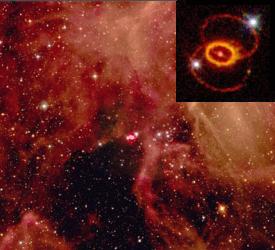SN 1987A
|
|
SN 1987A was a supernova in the Large Magellanic Cloud, a nearby dwarf galaxy. It occurred approximately 50 kiloparsecs from Earth, the closest supernova since SN 1604, which occurred in the Milky Way itself. The light from the supernova reached Earth on February 23, 1987. As the first supernova discovered in 1987, it was labeled "1987A". Its brightness peaked in May with a apparent magnitude of about 3 and slowly declined in the following months. It was modern astronomers' first opportunity to see a supernova up close.
Since 50 kiloparsecs is approximately 164,000 light-years, the cosmic event itself happened approximately 164,000 years ago.
Model studies indicate that 99% of the energy radiated by supernovae is in the form of neutrinos.
Approximately three hours before the visible light from SN 1987A reached the Earth, a burst of neutrinos was observed at three separate neutrino observatories (Kamiokande II, IMB and Baksan). At 7:35am Universal time, Kamiokande II detected 11 neutrinos, IMB 8 neutrinos and Baksan 5 neutrinos, in a burst lasting less than 13 seconds. Although the actual neutrino count was only 24, it was a significant rise from the previously-observed background level. This was the first time neutrinos emitted from a supernova had been observed directly, and the observations were consistent with theoretical supernova models in which most of the energy of the collapse is radiated away in neutrinos. The observations are also consistent with the models' estimates of a total neutrino count of <math>10^{58}<math> with a total energy of <math>10^{46}<math> joules. Template:Supernova One highly significant result was obtained from the data however. It appears that the neutrinos and antineutrinos both took the same time to arrive at earth, about 164,000 years, and from general relativity one would expect gravity to increase the travel time by about five months. The difference in their arrival times was less than 12 seconds. This is the first empirical evidence that matter and antimatter react similarly to gravitational fields, which was widely predicted but not previously tested directly.
Sanduleak -69° 202, the precursor to SN 1987A was a blue supergiant presumed to have a mass of about 20 solar masses. This required some revisions to models of high mass stellar evolution, which had suggested that supernovae would result from red supergiants.
The supernova remnant formed by debris from SN 1987A is one of the most-studied astronomical objects today.
External links
- Picture of Supernova 1987A (http://antwrp.gsfc.nasa.gov/apod/ap970124.html)
- More information on the discovery of SN 1987A (http://www.aavso.org/vstar/vsots/0301.shtml)
- Rochester Astronomy discovery timeline (http://www.rochesterastronomy.org/snimages/sn1987a.html)
- Gravitational effects on antimatter (http://math.ucr.edu/home/baez/physics/ParticleAndNuclear/antimatterFall.html)
- An Alternate View of SN1987A (http://www.geocities.com/peaceharris/sn1987a/index.html)de:Supernova 1987A
it:Supernova 1987a he:סופרנובה 1987A nl:Supernova 1987A fr:SN 1987A

